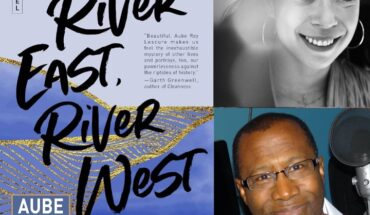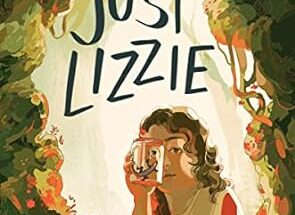 Carter Sickels’ much anticipated novel The Prettiest Star (Hub City Press) is a beautiful and moving story set in 1986 during the AIDS crisis. It follows Brian, a young man who leaves his life in New York City to return home to his family in a small Ohio town as he is dying of AIDS. The story is told through the perspectives of Brian as well as his mother and 14-year old sister as they struggle with Brian’s return and their own fears and prejudices.
Carter Sickels’ much anticipated novel The Prettiest Star (Hub City Press) is a beautiful and moving story set in 1986 during the AIDS crisis. It follows Brian, a young man who leaves his life in New York City to return home to his family in a small Ohio town as he is dying of AIDS. The story is told through the perspectives of Brian as well as his mother and 14-year old sister as they struggle with Brian’s return and their own fears and prejudices.
The Prettiest Star was named one of EW‘s 50 Most Anticipated Books of 2020, O Magazine’s “31 LGBTQ Books That’ll Change the Literary Landscape in 2020,” BookRiot’s “Most Anticipated LGBTQ Books of 2020,” Lambda Literary’s “Most Anticipated LGBTQ Books of May 2020,” and Salon‘s “Best and boldest new must-read books for May.”
To start off, what inspired you to choose this story and to set the story up with your main character going home to Ohio? How did you decide to structure the story that way?
CARTER SICKELS: I grew up in Ohio in a small town, and I was a teenager during the late 80s. I remembered watching an episode of Oprah filmed in a small town in West Virginia. A gay man, who was HIV-positive, had gone swimming in the public pool. He was kicked out of the pool, and the pool was disinfected. Oprah filmed the episode in the town, and the audience—his neighbors– were saying the most hateful, ugly things, and that memory of watching that show lodged itself in my brain. Years later, I thought about it and wondered, did that actually happen? I looked it up and found that, yes, it was a real incident. I was a teenager, a kid, watching the show. I had not come out yet. I had no understanding of my sexuality or gender, but the episode struck a nerve and stuck with me, not only for how cruel and vitriolic the audience was, but because I saw a gay man from a rural town sitting on stage. He was very confident and very out, which was powerful to me, although I couldn’t articulate it then.
I was thinking about what it would look like for a gay man to return to the small town in 1986 during the AIDS epidemic to a family that does not accept him or his sexuality but doesn’t entirely reject him either. Queer stories can be complicated in ways that often don’t get told or presented by the media. We usually see families fully accepting or completely rejecting their queer child. There can be a grayer, more complicated space, and it can be painful for people to exist in. With Brian’s story, I wondered how long his family would cling to their denial, even at the point where he’s literally dying in front of them, and they’re still not fully embracing him for who he is.
How did you prepare to tell Brian’s story as someone going through the physical experience of AIDS in 1986?
I read a lot of nonfiction from And the Band Played On by Randy Shilts to magazine articles from that period, like Life magazine, People magazine. The memoir Borrowed Time by Paul Monette that was really helpful and heartbreaking, about his experiences with AIDS and what was happening to his body. I watched many documentaries about AIDS. We Were Here by David Wiseman is one that struck me, about the AIDS epidemic in San Francisco. With that one, it really hit me how young so many of these men were. And there’s another documentary called Silverlake Life, about these two men, partners, who both were suffering from AIDS, that’s so powerful and intimate. They film each other and the suffering that they experienced, their physical decline, and this helped to understand what was going on with Brian’s body.
Is that one of the reasons you made Brian a video artist?
I knew he was going to be an artist of some type. I didn’t know for sure what kind when I started the novel. I thought maybe he’d be a writer, or an actor. It made sense to me that Brian was an artist, that he, like so many men, had left a small, conservative town to go to New York where he could be free, to be an artist and connect with the community. As I did more research, I started thinking about how video cameras were so popular then, and everyone wanted one. The videos gave me a way to set his sections apart from the other narrators, but were also a way for him to document his experiences and build the urgency. I think queer people felt desperate to record or document their stories because the larger population of the country wasn’t responding, wasn’t listening and was ignoring what was happening. Video was a way to preserve their voices and tell their stories.
You include Brian’s perspective as his video diary, but you also include his mother and his sister. Why was it important to you to get those multiple perspectives on the story?
I’ve always been drawn to novels that use multiple narrators. For me, this was a story that required more than just Brian’s perspective. It is absolutely his story, and I never questioned that–I wasn’t going to tell a story about a gay man dying of AIDS where he had no voice. But it’s also a story of this family. In some ways, this family represents what was going on across America, a sort of refusal to take care of their children and protect them. I think that the multiple point of view opens up a wider world to the reader. It also builds tension and creates complexity by showing these different relationships from different angles.I started writing from his sister Jess’s perspective early on, thinking about what it would be like for her brother to come back, a brother she loved and looked up to. She doesn’t know why he left or why he’s returned. The parents keep it a secret from her that he’s gay and is HIV positive. Jess has a youthful voice, but she is very savvy and can articulate a lot that her mother cannot. She also brings some humor and a little levity to the story. I wrote from Sharon, their mother’s point of view, after I’d been working on the novel for a few months. She was difficult in some ways because my worldview is very different from hers, but I wanted to write her with empathy and depth. The first person can reveal a character’s blind spots. With Sharon, her homophobia is so deep she can’t see it. She loves her son, but she’s also terrified of what the church will think or what the neighbors will think.
In the second half of the novel, Brian really starts to suffer physically. Was it hard to write that? Did you have concerns about telling that part of the story without sensationalizing the pain?
It felt important to show the physical suffering, the reality of AIDS on the body in 1986. It didn’t feel particularly emotionally hard to write, except that I didn’t want to sensationalize it. I didn’t want to glamorize it, either. There were times where I hit these walls of doubt where I wondered if Brian should live through this, but the truth for so many people diagnosed with AIDS, during the 80s and early 90s, was that it was a death-sentence. I didn’t want to not tell that story because it was too hard for me. I wanted the reader to look at Brian, to see the truth, and not look away. I also wanted to resist this idea that death is transformative, or turn Brian into a martyr.
Once you decided that he was going to die, was it challenging to find the narrative question for the story?
I never know exactly what a book is going to be about when I start it. I usually start with the characters, the setting, and write my way into it. One of the narrative questions I engaged with early on was about the family’s refusal to acknowledge or see their son’s queerness, even when he’s actually dying in front of them. As the characters became more complex, the novel grew into a family love story—it’s about a family that comes apart. I didn’t want to let anyone off the hook or have them be easily redeemed. I think that’s part of what the novel is about. How do they fail each other, but, then, how do they care for each other? I resisted tying the narrative up in a neat bow.
Because The Prettiest Star is set in 1986, it is a very different time, especially in terms of the acceptance of the queer community. Historical fiction tells untold stories, but it also reflects the current moment. Were you thinking about the current moment when you were writing?
Early on I was just following my characters, but as the novel grew, I began to interrogate myself, asking questions like, “What is this about?” and “What is the point?” I wanted to tell a story about the AIDS crisis and the stigma associated with HIV/AIDS, and about rural America. I wanted to write about a part of queer identity and history that we don’t often hear about. Because people often had to be closeted, especially in a small town–the reaction was, “We don’t want to talk about AIDS because then we’re going to have to talk about you being gay. And then we have to talk about sex and gay sex.” It’s impossible for Brian’s family and the town to separate his sexuality from the disease.
When I started the novel—actually when I wrote the bulk of it—Obama was still president. It was a different time. More hopeful, more optimistic. There were conversations starting to happen about support for trans people. Now, under the Trump administration, there’s been so much backlash, especially toward the trans community.
This administration is working hard to reverse any kind of gains that LGBTQ community made, and they are making our lives more difficult and precarious. There are so many queer and trans kids who are not being protected by their families, the government, their schools. Homophobia, transphobia are still going strong. We have to keep telling these stories from the past and from present day in order to dismantle those oppressive attitudes. And although my novel is about a very specific time in American history, AIDS is not over—there is no cure, and people are still battling this illness, people are still dying from AIDS.
It will be interesting to see how the novel will read to young people who haven’t lived in that world, not that everything’s perfect now, but it’s certainly not like the absolute rejection that happens in this town. Do you think young people today might not understand Brian’s situation?
I have gotten feedback from a few younger readers who were shocked by some of the details, like Brian’s family requiring him to use separate plates and silverware. It was shocking, but I hope the book is empowering, too–to see where we were in the ‘80s and where we are now, and still where we need to go to become a more just society. I’ve had students, especially from rural areas, who learned nothing in high school about the AIDS epidemic, a part of history that has been completely denied to them, because teachers or parents don’t want to talk about gay people. My students are angry about this and fired up– they’ve told me, they don’t want to be like the conservative members of their town, they don’t want to carry that kind of shame or of prejudice.
If we are talking about epidemics, I have to ask. How does it feel to have your book launch during this unprecedented time?
It’s been very surreal, but bookstores and publishers and the writing community are being inventive and supportive as we move over to the virtual world. We’re all doing our best. It seems like people are hungry to read right now, and I hope we can all support the independent bookstores. They need our help. But, yeah, it’s strange to send this book about an epidemic from the 80s and 90s into the new world that’s experiencing a global pandemic.
I think people want something that they can get totally engulfed in. I want things that take my attention away from all the other stuff. Reading The Prettiest Star was definitely that experience. With that said, what are you reading now and what do you recommend? What have you been in love with?
Two fantastic debut story collections I just read will be out soon. We Had No Rules by Corinne Manning, about queer experiences, queer lives, is wonderful. The other one, by Leah Hampton, has the incredible title Fuckface. These are funny, surprising, smart stories set in Appalachia. I am excited to read Paul Lisicky’s new memoir, Later, about his experiences as a gay man living in Provincetown during the height of the AIDS epidemic. And, because I needed some respite from the onslaught of news and coronavirus-induced anxiety, I started Wolf Hall by Hillary Mantel.
Carter Sickels is the author of the novel The Prettiest Star. His debut novel The Evening Hour (Bloomsbury 2012), an Oregon Book Award finalist and a Lambda Literary Award finalist, was adapted into a feature film that premiered at the 2020 Sundance Film Festival. His essays and fiction have appeared in a variety of publications, including Oxford American, Poets & Writers, BuzzFeed, Guernica, and the Bellevue Literary Review.




1 comment